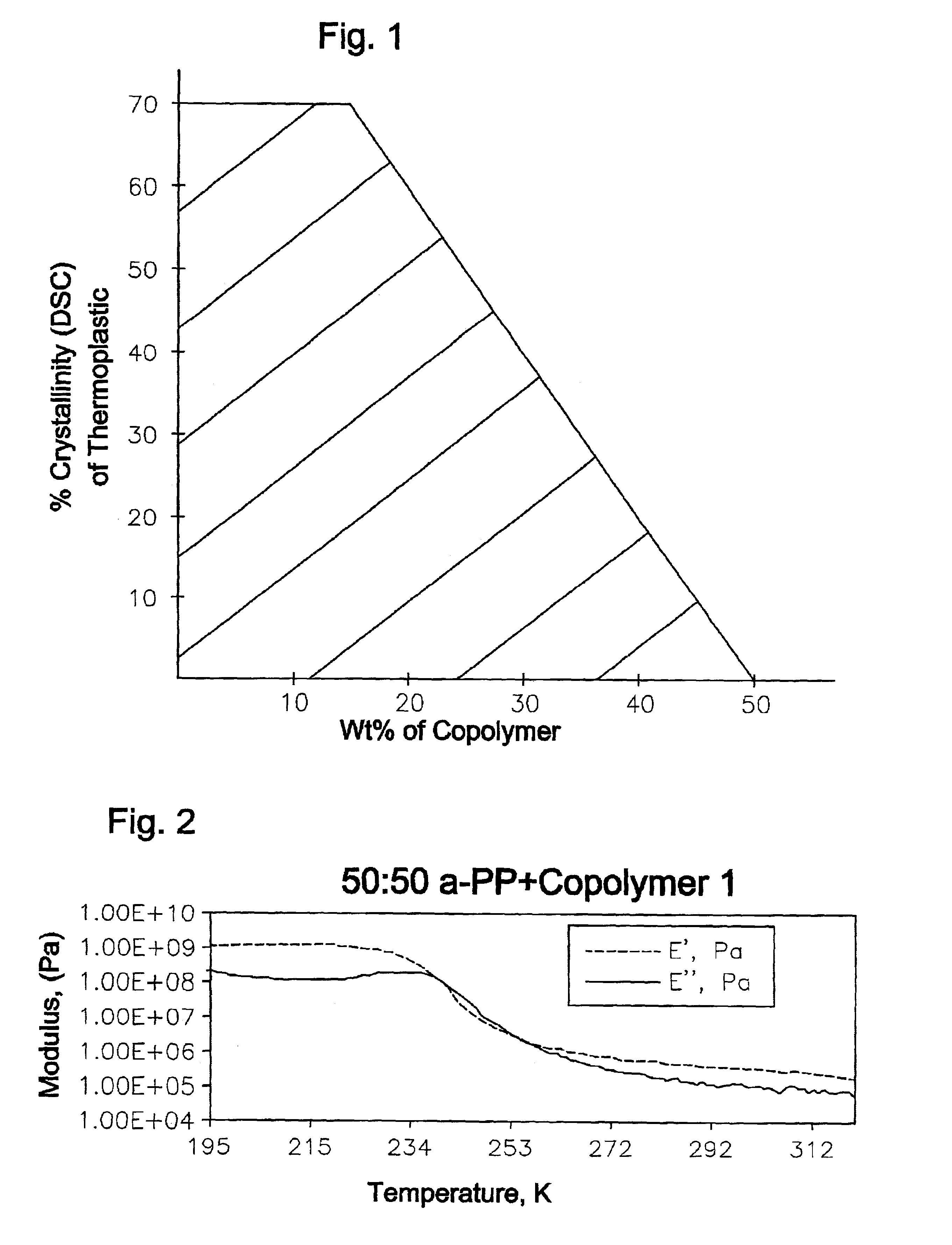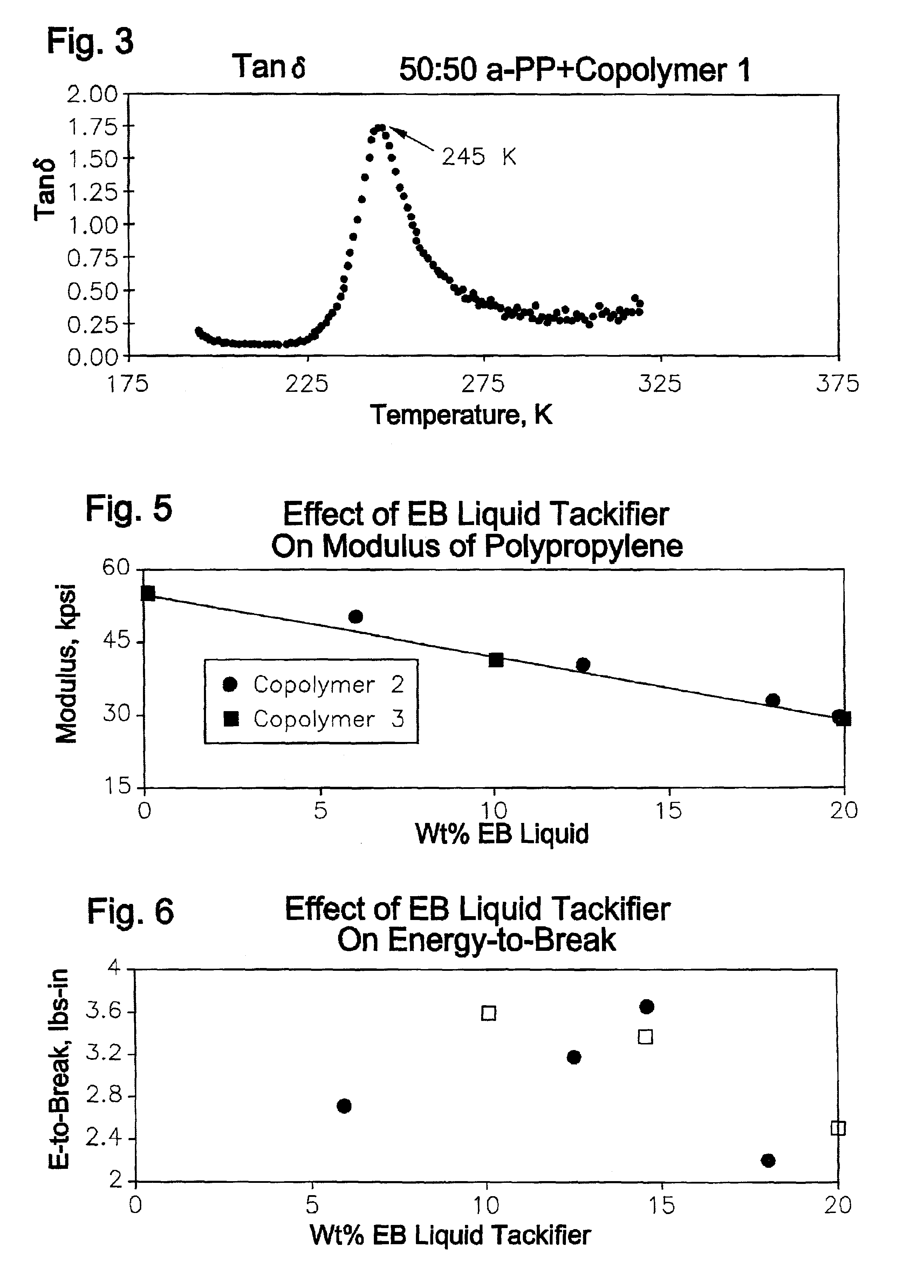Plasticized polypropylene thermoplastics
- Summary
- Abstract
- Description
- Claims
- Application Information
AI Technical Summary
Benefits of technology
Problems solved by technology
Method used
Image
Examples
example 1
[0060]The glass transition temperatures measured by dynamic mechanical thermal analysis (“DMTA”—tan δ peak) for blends of plasticizer liquids and elastomeric polypropylene (ePP) and amorphous polypropylene (aPP) are listed in Table 3.
[0061]DMTA measurements were determined by placing approximately 0.8 grams of the sample in a Rheometrics 25 mm vacuum mold. A plunger is inserted into the mold, using a 1″ spacer to hold the plunger above the vacuum port. This assembly is placed in a Carver press. The sample chamber is evacuated for at least 5 min. at ambient temperature and then heated to 190° C. and held at that temperature for 10 min. while still under vacuum. After this period, the press heater is turned off, the spacer removed, and 5,000 lbs. of pressure applied while a nitrogen purge is passed through the mold cooling port. Once the sample has cooled to room temperature, the plunger is pushed out of the mold using a press and the plunger removal tool. Cooling to lower temperature...
example 2
[0066]Density results for two blends of aPP (described in Example 1) with copolymers 1 and 2 are compared with the density of the unblended aPP are reported in Table 4. Density was measured using a density gradient column (ASTM D-792).
[0067]
TABLE 4Density Comparison (23° C.):aPP versus Examples of Plasticized aPPDensity, g / cm3CopolymerCopolymer Liquid, wt %@ 23° C.None 00.8525Copolymer 1500.8591Copolymer 2500.8592
[0068]The density measured for the unblended aPP is comparable to those reported for amorphous polypropylene in the literature. The increased density (0.007 g / cm) of the blends relative to the unblended aPP indicates a substantial reduction in “void volume”. This reduction in void volume is suggestive of miscibility of the blends.
example 3
[0069]Dynamic mechanical thermal analysis of the 50:50 blend of aPP (Example 1)+Copolymer 1 was measure, and the results illustrated in FIG. 2. The peak in tan δ occurs at 245° K and is illustrated in FIG. 3. This value is in good agreement with the Tg measured for this blend by DSC at a scan rate of 10° C. per minute (242° K). DMTA of this same aPP without plasticizer gives a peak at 276° K.
[0070]DMTA's were measured (not illustrated) for two other blends: ePP (Example 1)+Copolymer 3 and aPP (Example 1)+Copolymer 3. The Tg's measured from DMTA and DSC for these three blends are compared in Table 5. Agreement between the two methods is good.
[0071]
TABLE 5Comparison of Tg Measured by DSC and DMTABlendThermoplasticTg, °KPolymer (wt %)Copolymer (wt %)DSCDMTAe-PP a (60)Copolymer 2 (40)256258a-PP a (50)Copolymer 2 (50)245247a-PP a (50)Copolymer 1 (50)242245a The thermoplastic polymers described in Example 1.
[0072]In all three blend DMTA's, the tan δ peak was substantially broader than th...
PUM
| Property | Measurement | Unit |
|---|---|---|
| Fraction | aaaaa | aaaaa |
| Fraction | aaaaa | aaaaa |
| Glass transition temperature | aaaaa | aaaaa |
Abstract
Description
Claims
Application Information
 Login to View More
Login to View More - R&D
- Intellectual Property
- Life Sciences
- Materials
- Tech Scout
- Unparalleled Data Quality
- Higher Quality Content
- 60% Fewer Hallucinations
Browse by: Latest US Patents, China's latest patents, Technical Efficacy Thesaurus, Application Domain, Technology Topic, Popular Technical Reports.
© 2025 PatSnap. All rights reserved.Legal|Privacy policy|Modern Slavery Act Transparency Statement|Sitemap|About US| Contact US: help@patsnap.com



